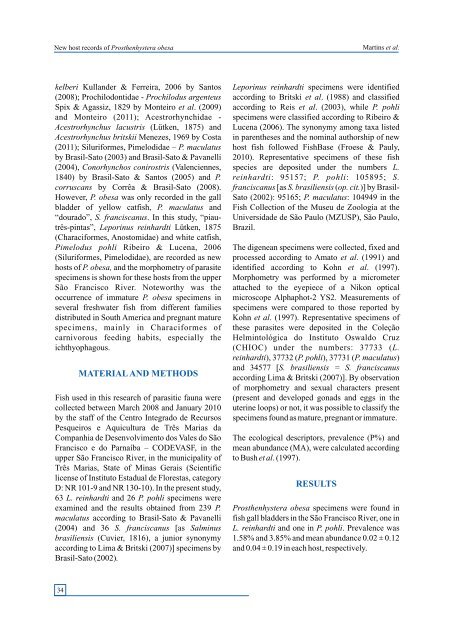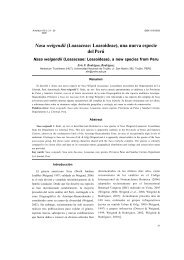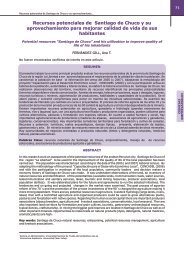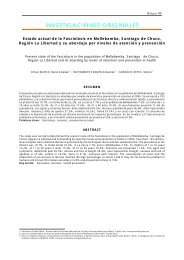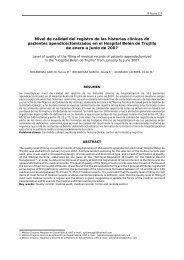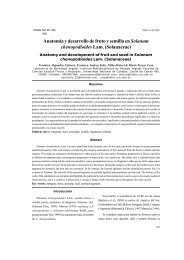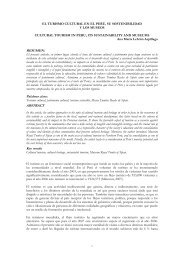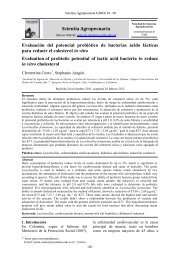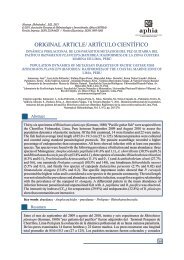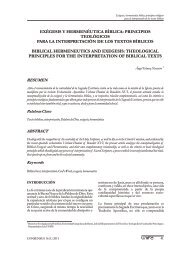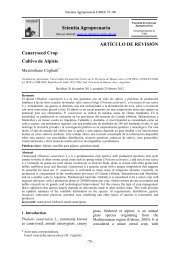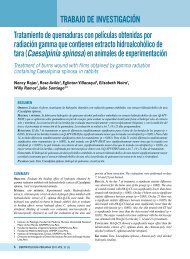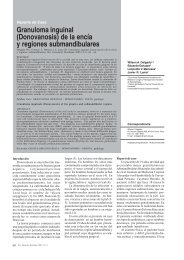neotropical vol. 6 - Portal del Sistema de Bibliotecas de la UNMSM
neotropical vol. 6 - Portal del Sistema de Bibliotecas de la UNMSM
neotropical vol. 6 - Portal del Sistema de Bibliotecas de la UNMSM
Create successful ePaper yourself
Turn your PDF publications into a flip-book with our unique Google optimized e-Paper software.
New host records of Prosthenhystera obesaMartins et al.kelberi Kul<strong>la</strong>n<strong>de</strong>r & Ferreira, 2006 by Santos(2008); Prochilodontidae - Prochilodus argenteusSpix & Agassiz, 1829 by Monteiro et al. (2009)and Monteiro (2011); Acestrorhynchidae -Acestrorhynchus <strong>la</strong>custris (Lütken, 1875) andAcestrorhynchus britskii Menezes, 1969 by Costa(2011); Siluriformes, Pimelodidae – P. macu<strong>la</strong>tusby Brasil-Sato (2003) and Brasil-Sato & Pavanelli(2004), Conorhynchos conirostris (Valenciennes,1840) by Brasil-Sato & Santos (2005) and P.corruscans by Corrêa & Brasil-Sato (2008).However, P. obesa was only recor<strong>de</strong>d in the gallb<strong>la</strong>d<strong>de</strong>r of yellow catfish, P. macu<strong>la</strong>tus and“dourado”, S. franciscanus. In this study, “piautrês-pintas”,Leporinus reinhardti Lütken, 1875(Characiformes, Anostomidae) and white catfish,Pimelodus pohli Ribeiro & Lucena, 2006(Siluriformes, Pimelodidae), are recor<strong>de</strong>d as newhosts of P. obesa, and the morphometry of parasitespecimens is shown for these hosts from the upperSão Francisco River. Noteworthy was theoccurrence of immature P. obesa specimens inseveral freshwater fish from different familiesdistributed in South America and pregnant maturespecimens, mainly in Characiformes ofcarnivorous feeding habits, especially theichthyophagous.MATERIAL AND METHODSFish used in this research of parasitic fauna werecollected between March 2008 and January 2010by the staff of the Centro Integrado <strong>de</strong> RecursosPesqueiros e Aquicultura <strong>de</strong> Três Marias daCompanhia <strong>de</strong> Desen<strong>vol</strong>vimento dos Vales do SãoFrancisco e do Parnaíba – CODEVASF, in theupper São Francisco River, in the municipality ofTrês Marias, State of Minas Gerais (Scientificlicense of Instituto Estadual <strong>de</strong> Florestas, categoryD: NR 101-9 and NR 130-10). In the present study,63 L. reinhardti and 26 P. pohli specimens wereexamined and the results obtained from 239 P.macu<strong>la</strong>tus according to Brasil-Sato & Pavanelli(2004) and 36 S. franciscanus [as Salminusbrasiliensis (Cuvier, 1816), a junior synonymyaccording to Lima & Britski (2007)] specimens byBrasil-Sato (2002).Leporinus reinhardti specimens were i<strong>de</strong>ntifiedaccording to Britski et al. (1988) and c<strong>la</strong>ssifiedaccording to Reis et al. (2003), while P. pohlispecimens were c<strong>la</strong>ssified according to Ribeiro &Lucena (2006). The synonymy among taxa listedin parentheses and the nominal authorship of newhost fish followed FishBase (Froese & Pauly,2010). Representative specimens of these fishspecies are <strong>de</strong>posited un<strong>de</strong>r the numbers L.reinhardti: 95157; P. pohli: 105895; S.franciscanus [as S. brasiliensis (op. cit.)] by Brasil-Sato (2002): 95165; P. macu<strong>la</strong>tus: 104949 in theFish Collection of the Museu <strong>de</strong> Zoologia at theUniversida<strong>de</strong> <strong>de</strong> São Paulo (MZUSP), São Paulo,Brazil.The digenean specimens were collected, fixed andprocessed according to Amato et al. (1991) andi<strong>de</strong>ntified according to Kohn et al. (1997).Morphometry was performed by a micrometerattached to the eyepiece of a Nikon opticalmicroscope Alphaphot-2 YS2. Measurements ofspecimens were compared to those reported byKohn et al. (1997). Representative specimens ofthese parasites were <strong>de</strong>posited in the ColeçãoHelmintológica do Instituto Oswaldo Cruz(CHIOC) un<strong>de</strong>r the numbers: 37733 (L.reinhardti), 37732 (P. pohli), 37731 (P. macu<strong>la</strong>tus)and 34577 [S. brasiliensis = S. franciscanusaccording Lima & Britski (2007)]. By observationof morphometry and sexual characters present(present and <strong>de</strong>veloped gonads and eggs in theuterine loops) or not, it was possible to c<strong>la</strong>ssify thespecimens found as mature, pregnant or immature.The ecological <strong>de</strong>scriptors, prevalence (P%) andmean abundance (MA), were calcu<strong>la</strong>ted accordingto Bush et al. (1997).RESULTSProsthenhystera obesa specimens were found infish gall b<strong>la</strong>d<strong>de</strong>rs in the São Francisco River, one inL. reinhardti and one in P. pohli. Prevalence was1.58% and 3.85% and mean abundance 0.02 ± 0.12and 0.04 ± 0.19 in each host, respectively.34


